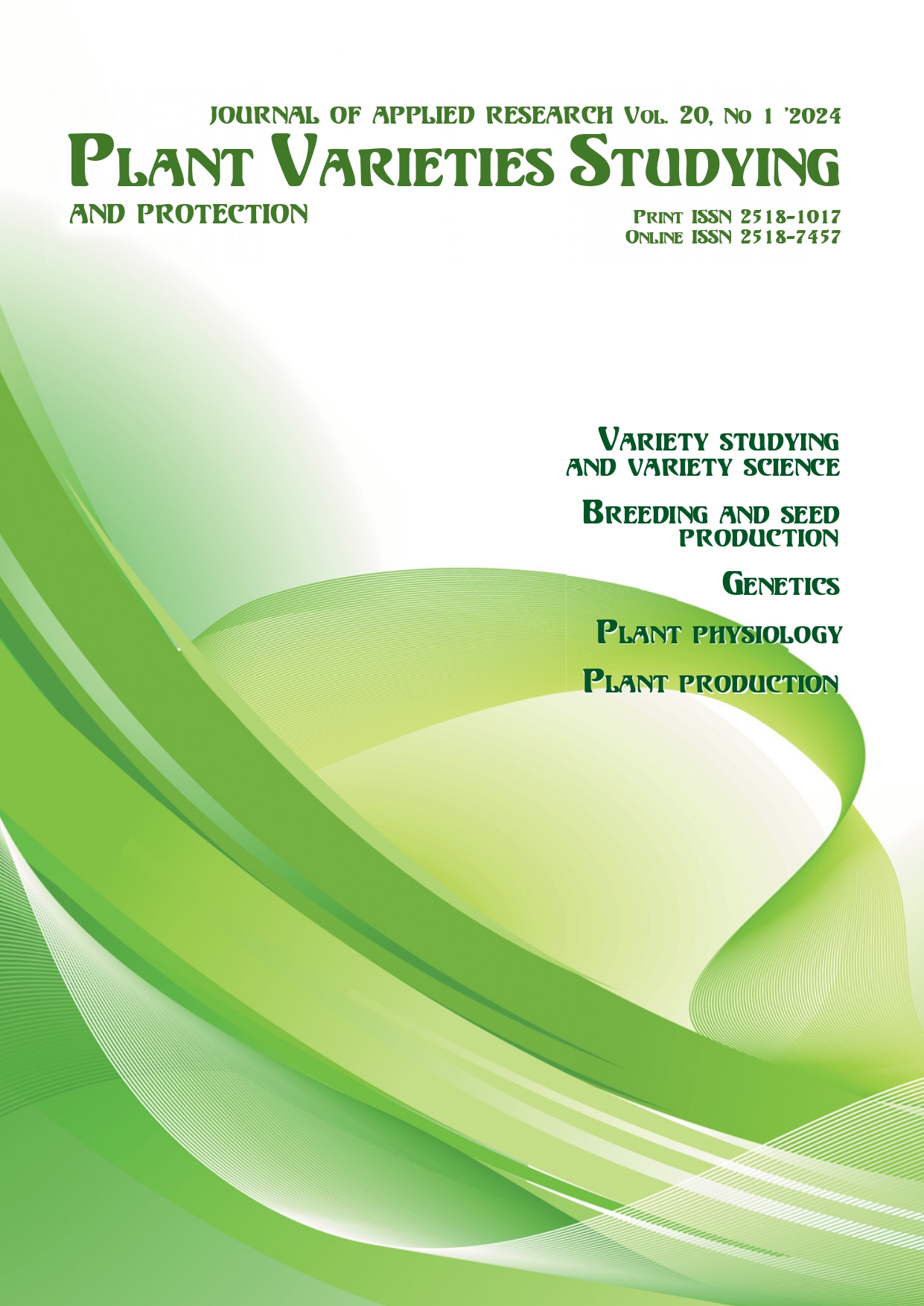Morphology of generative organs of Morus alba L. cultivars introduced in the conditions of the Forest Steppe of Ukraine
DOI:
https://doi.org/10.21498/2518-1017.20.1.2024.301194Keywords:
flowering, seed productivity, germination energy, pollen, sexual dimorphismAbstract
Purpose. The aim was to study the features of flowering and fruiting of the mulberry under conditions of the RightBank ForestSteppe of Ukraine. Methods. The research was conducted in the forest steppe zone at the experimental base of the Institute of Horticulture of the NAAS in 2021–2023. The subject was plant material of different cultivars of mulberry (Morus alba), propagated from seed progeny of the ‘Krupnoplidna’ variety; selffertile mulberry plants were used as a control. The morphological description of the structural elements of the reproductive organs and the study of pollen viability were carried out according to published methods. The fruiting of the breeding forms was evaluated on a fivepoint scale. Results. All plants tested were found to have the ability to germinate pollen. The most viable pollen (75.1%) was found in male breeding form No. 5 after 12 hours exposure and a sucrose concentration of 50%. Exposure for 24 hours caused a decrease in germination energy of up to 63.1%. The latter was lowest in the pollen grains of plants of the triploid sample at both sucrose concentrations used. The comparison of morphological characteristics and seed productivity (per fruit) of the breeding forms of M. alba showed the genetic diversity of plants of cultivars of the species, which is manifested in the difference of phenotypic characteristics due to the variability of the range of their expression. Conclusions. The highest rates of white mulberry pollen germination were obtained for breeding form No. 5 – 79.1 ± 0.36% (male specimen) with 25% concentration of sucrose in the nutrient medium. The number of fruits formed on twoyearold shoots was 21–91. The evaluation of the fruiting of the cultivars was 4–5 points, and their infructescences were 2.26–3.97 cm long (large). In general, the study of the morphology of the reproductive organs of the breeding forms of M. alba, each of which forms filled seeds with high germination energy (91–98%), showed the intactness of the reproductive functions of mulberry, which indicates the successful passage of the plants through all stages of organogenesis.
Downloads
References
Shynkarova, D. M. (2020). Agrobiological features fructification mulberryunder Transcarpathian region. Problems of the AgroIndustrial Complex of the Carpathians, 28, 99–104. doi: 10.47279/2709-3727-2020-2-8 [In Ukrainian]
Ercisli, S., & Orhan, E. (2007). Chemical composition of white (Morus alba), red (Morus rubra) and black (Morus nigra) mulberry fruits. Food Chemistry, 103(4), 1380–1384. doi: 10.1016/ j.foodchem.2006.10.054
Ozdemir, F., & Topuz, A. (1998). Some chemical composition of mulberries grown in Antalya. Derim, 15(1), 30–35.
Ozgen, M., Serce, S., & Kaya, C. (2009). Phytochemical and antioxidant properties of anthocyaninrich Morus nigra and Morus alba fruits. Scientia Horticulturae, 119(3), 275–279. doi: 10.1016/j.scienta.2008.08.007
Oleksiichenko, N. O. (2005). Results of mulberry breeding for fertility in Ukraine. Bulletin of Poltava State Agrarian Academy, 1, 23–25. [In Ukrainian]
Mitina, L. V. (2002). Fruit mulberry Morus alba L. in the southeast of Ukraine. Kyiv: Naukova Dumka. [In Ukrainian]
Vitenko, V. A. (2008). Morus alba L. – a valuable fruit, decorative, and medicinal plant. Scientific Bulletin of the National Forestry University of Ukraine, 18(1), 17–22. [In Ukrainian]
Babaieva, G. I., Litvin, V. M., & Voitenko, V. I. (2021). Ukrainian and introduced mullberry (Morus L.) fruit varieties. Plant Genetic Resources, 29, 11–19. doi: 10.36814/pgr.2021.29.01 [In Ukrainian]
RudnykIvashchenko, O. I., & Sukhomlyn, L. V. (2017). Mulberry (Morus L.): Its realities and future in Ukraine. Horticulture, 72, 45–49. [in Ukrainian]
Scalzo, J., Politi, A., Pellegrini, N., Mezzetti, B., & Battino, M. (2005). Plant genotype affects total antioxidant capacity and phenolic contents in fruit. Nutrition, 21(2), 207–213. doi: 10.1016/j.nut.2004.03.025

Hluhov, O. Z. (2003). Mulberry Morus alba L. in the southeast of Ukraine (Introduction, biomorphology, utilization). Donetsk: Lebid. [In Ukrainian]
Holubinskyi, I. M. (1974). Biology of pollen germination. Kyiv: Naukova Dumka. [In Ukrainian]
Oleksiichenko, N. O. (2007). Mulberry breeding in Ukraine. Kyiv: VTs KNLU. [In Ukrainian]
Alekseieva, T. H. (2012). Determining the viability of pollen and embryo sac: Guidelines for a large special practicum. Odesa: N. p. [In Ukrainian]
Mitina, L. V. (2008). Features of seed propagation of Morus alba L. Abstracts of reports of the conference of young scientists (pp. 82–83). Kherson. [In Ukrainian]
Methodology for examination of varieties of fruit, berry, nut and grape plant varieties for distinction, homogeneity and stability. Retrieved from https://www.sops.gov.ua/uploads/page/Meth_DUS/2023/Method_fruit_2023.pdf
Tarasenko, R. O. (2008). Information technologies. Kyiv: Alefa. [In Ukrainian]
Downloads
Published
How to Cite
Issue
Section
License
Copyright (c) 2024 O. I. Rudnyk-Ivashchenko, O. V. Haievskyi

This work is licensed under a Creative Commons Attribution-ShareAlike 4.0 International License.
Starting in 2022, the copyright to the publication remains with the authors
Our journal abides by the CREATIVE COMMONS copyright rights and permissions for open access journals.
Authors, who are published in this journal, agree to the following conditions:
- The authors reserve the right to authorship of the work and pass the first publication right of this work to the journal under the terms of a Creative Commons Attribution License, which allows others to freely distribute the published research with the obligatory reference to the authors of the original work and the first publication of the work in this journal.
- The authors have the right to conclude separate supplement agreements that relate to non-exclusive work distribution in the form in which it has been published by the journal (for example, to upload the work to the online storage of the journal or publish it as part of a monograph), provided that the reference to the first publication of the work in this journal is included.

























 Ukrainian Institute for Plant Varieties Examination
Ukrainian Institute for Plant Varieties Examination  Селекційно-генетичний інститут
Селекційно-генетичний інститут Institute of Plant Physiology and Genetics of the National Academy of Sciences of Ukraine
Institute of Plant Physiology and Genetics of the National Academy of Sciences of Ukraine
 The National Academy of Agrarian Sciences of Ukraine
The National Academy of Agrarian Sciences of Ukraine